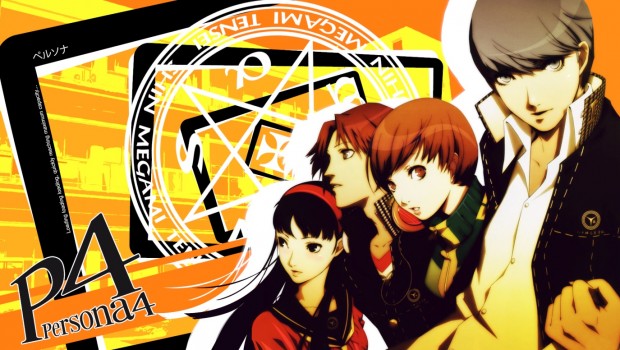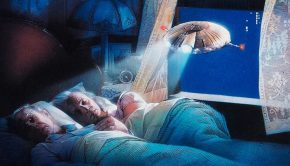Persona 4: The Animation
Summary: Probably the biggest weakness of Persona 4: The Animation is that it’s an adaptation first and foremost; it assumes that the viewer is familiar with the source material and as such is a very esoteric experience.
3.9
Esoteric
I’ll admit to feeling quite a bit lost when I first started viewing this release, being unfamiliar with either the first 17 episodes of the series and the RPG game it’s based upon and although a quick look online clarified the main points of the story, I still found watching Persona 4: The Animation to be a confusing experience. Aside from watching random episodes of Dragonball Z and One Piece as a youth, my experience with Anime is quite limited, and although I did enjoy both Ghost in the Shell and Akira, I wouldn’t go so far as to call myself a fan. This, coupled with a complete lack of knowledge regarding the extensive source material upon which the series is based upon, made reviewing this release a rather daunting prospect.
Catching up on the plot of the preceding episodes via online synopses, the basic premise of the show seems to revolve around a new student named Yu Narukami who moves to Inaba from the city only to find himself embroiled in a murder investigation when the body of a local TV presenter is found hanging from an aerial. Discovering a distorted TV world accessible by viewing a mysterious program called The Midnight Channel, Yu and his friends soon venture within it in order to discover the source of the murders, finding themselves transformed into “Personas”, super-powered avatars that replace the corporeal forms of the characters whilst in this alternate realm.
This release collects episodes 18 – 26 and picks up after the murders are apparently solved with the arrest of one of Yu’s fellow students Mitsuo Kubo; only Yu and his friends know that Kubo was only responsible for the unrelated death of their homeroom teacher and is being used by the police as a scapegoat to alleviate public distress.
The early episodes focus on Yu and his friends bonding rather than their exploits in the world of The Midnight Channel, including a bizarre episode featuring a beauty pageant where many of the main male characters participate in drag; later episodes return the focus to the mysteries of the TV world when Yu’s young cousin Nanako gets drawn into The Midnight Channel and looks set to be its next victim. This kicks off an arc that takes place predominately in Nanako’s “Heaven” world followed by the reveal of the ultimate culprit behind everything, set in a world of his imagining.
As I mentioned before, Persona 4: The Animation can be rather confusing for anyone unfamiliar with its RPG source material, as the show offers very little in the way of exposition; certain plot elements can be picked up through conversations, such as the character of Teddie actually hailing from the alternate world, where he appears as a literal anthropomorphic Teddy Bear, but without having prior knowledge of the show’s influence you can quickly lose track of characters and the myriad of plotlines. Yu’s friendship with the other characters is a strong thread that runs through the show, eschewing the lone wolf mentality of similar programs, and the final discovery of the true puppet master behind the scenes is a fairly decent payoff, although the final battle itself is a tad underwhelming.
As it’s an adaptation of a game with multiple endings, the series proper only focuses on Persona 4’s “Good” ending, with its “True” ending, the 26th episode ‘No One is alone’, included as a bonus OVA episode; this episode rewrites many of the pivotal moments of the series and explore tangential offshoots of the plot that seemingly reflect differences that occurred in the game when played a second time through. An interesting idea, albeit adding even more to the confusion for newcomers, the episode itself comes off as being a bit rushed but will undoubtedly be a great addition for fans familiar with the canon of the series.
Despite coming in late and, by proxy, spending most of the series playing catch up and connecting the dots, I actually found Persona 4: The Animation to be fairly enjoyable. Once I’d familiarised myself with the basic tenets of the series and come to terms with its unique premise, I was sufficiently engaged by the storyline to watch it to its conclusion without it feeling like a chore. The characters are likeable enough and the action sequences carry weight, although some of the more idiosyncratic aspects of Japanese culture still bewilder me, such as the fascination with cross-dressing and the juxtaposition of the often goofy comedic sensibilities against the more intense and darker moments.
Episode Listing:
– Anniversary to Become a Family
– It’s School Festival Day! Time to Have Fun!
– We’ll All Meet at the AMAGIYA Hotel!
– Don’t Save Anyone Anymore
– It’s Just Like Heaven
– In Order to Find the Truth
– The World is Full of Shit
– We Can Change the World
– No One is Alone
Audio/ Visual
Madman’s transfer is of the highest quality, with clean lines, vivid colouring and a consistent image quality throughout that accentuates the terrific quality of the animation. Blacks are suitably inky and there is no evidence of aliasing or compression artefacts to be seen. Audio is presented in 2.0 rather than 5.1 but the sound quality doesn’t suffer at all, with the genuinely catchy theme song and music throughout all coming through crystal clear.
I’ll admit to feeling quite a bit lost when I first started viewing this release, being unfamiliar with either the first 17 episodes of the series and the RPG game it’s based upon and although a quick look online clarified the main points of the story, I still found watching Persona 4: The Animation to be a confusing experience. Aside from watching random episodes of Dragonball Z and One Piece as a youth, my experience with Anime is quite limited, and although I did enjoy both Ghost in the Shell and Akira, I wouldn’t go so far as to call myself a fan. This, coupled with a complete lack of knowledge regarding the extensive source material upon which the series is based upon, made reviewing this release a rather daunting prospect.
Catching up on the plot of the preceding episodes via online synopses, the basic premise of the show seems to revolve around a new student named Yu Narukami who moves to Inaba from the city only to find himself embroiled in a murder investigation when the body of a local TV presenter is found hanging from an aerial. Discovering a distorted TV world accessible by viewing a mysterious program called The Midnight Channel, Yu and his friends soon venture within it in order to discover the source of the murders, finding themselves transformed into “Personas”, super-powered avatars that replace the corporeal forms of the characters whilst in this alternate realm.
This release collects episodes 18 – 26 and picks up after the murders are apparently solved with the arrest of one of Yu’s fellow students Mitsuo Kubo; only Yu and his friends know that Kubo was only responsible for the unrelated death of their homeroom teacher and is being used by the police as a scapegoat to alleviate public distress.
The early episodes focus on Yu and his friends bonding rather than their exploits in the world of The Midnight Channel, including a bizarre episode featuring a beauty pageant where many of the main male characters participate in drag; later episodes return the focus to the mysteries of the TV world when Yu’s young cousin Nanako gets drawn into The Midnight Channel and looks set to be its next victim. This kicks off an arc that takes place predominately in Nanako’s “Heaven” world followed by the reveal of the ultimate culprit behind everything, set in a world of his imagining.
As I mentioned before, Persona 4: The Animation can be rather confusing for anyone unfamiliar with its RPG source material, as the show offers very little in the way of exposition; certain plot elements can be picked up through conversations, such as the character of Teddie actually hailing from the alternate world, where he appears as a literal anthropomorphic Teddy Bear, but without having prior knowledge of the show’s influence you can quickly lose track of characters and the myriad of plotlines. Yu’s friendship with the other characters is a strong thread that runs through the show, eschewing the lone wolf mentality of similar programs, and the final discovery of the true puppet master behind the scenes is a fairly decent payoff, although the final battle itself is a tad underwhelming.
As it’s an adaptation of a game with multiple endings, the series proper only focuses on Persona 4’s “Good” ending, with its “True” ending, the 26th episode ‘No One is alone’, included as a bonus OVA episode; this episode rewrites many of the pivotal moments of the series and explore tangential offshoots of the plot that seemingly reflect differences that occurred in the game when played a second time through. An interesting idea, albeit adding even more to the confusion for newcomers, the episode itself comes off as being a bit rushed but will undoubtedly be a great addition for fans familiar with the canon of the series.
Despite coming in late and, by proxy, spending most of the series playing catch up and connecting the dots, I actually found Persona 4: The Animation to be fairly enjoyable. Once I’d familiarised myself with the basic tenets of the series and come to terms with its unique premise, I was sufficiently engaged by the storyline to watch it to its conclusion without it feeling like a chore. The characters are likeable enough and the action sequences carry weight, although some of the more idiosyncratic aspects of Japanese culture still bewilder me, such as the fascination with cross-dressing and the juxtaposition of the often goofy comedic sensibilities against the more intense and darker moments.
Episode Listing:
– Anniversary to Become a Family
– It’s School Festival Day! Time to Have Fun!
– We’ll All Meet at the AMAGIYA Hotel!
– Don’t Save Anyone Anymore
– It’s Just Like Heaven
– In Order to Find the Truth
– The World is Full of Shit
– We Can Change the World
– No One is Alone
Audio/ Visual
Madman’s transfer is of the highest quality, with clean lines, vivid colouring and a consistent image quality throughout that accentuates the terrific quality of the animation. Blacks are suitably inky and there is no evidence of aliasing or compression artefacts to be seen. Audio is presented in 2.0 rather than 5.1 but the sound quality doesn’t suffer at all, with the genuinely catchy theme song and music throughout all coming through crystal clear.
Special Features
Besides the aforementioned bonus OVA episode, Persona 4: The Animation has a short, crudely animated clip starring a ninja named Dr. Experiment, A sing-along of the guitar driven opening song and of another poppier song that I’m sure fans will be far more familiar with than I was but that didn’t stop me tapping my foot along with it. The music in the show is extremely catchy (and probably one of my favourite things about the series) and it’s nice to have the option of hearing a few isolated tracks, although they are both rather short. Each episode, aside from ‘No One is Alone’, comes with the option of listening to the dubbed English track or the original Japanese edit with subtitles.
List of Features:
– OVA Episode 26 ‘No One is Alone’ (30:01)
– Jikken-Kun (Drama 4) (1:22)
– Opening 2nd Period (1:26)
– Ending Arcane Complete Version (1:26)
Besides the aforementioned bonus OVA episode, Persona 4: The Animation has a short, crudely animated clip starring a ninja named Dr. Experiment, A sing-along of the guitar driven opening song and of another poppier song that I’m sure fans will be far more familiar with than I was but that didn’t stop me tapping my foot along with it. The music in the show is extremely catchy (and probably one of my favourite things about the series) and it’s nice to have the option of hearing a few isolated tracks, although they are both rather short. Each episode, aside from ‘No One is Alone’, comes with the option of listening to the dubbed English track or the original Japanese edit with subtitles.
List of Features:
– OVA Episode 26 ‘No One is Alone’ (30:01)
– Jikken-Kun (Drama 4) (1:22)
– Opening 2nd Period (1:26)
– Ending Arcane Complete Version (1:26)
Final Thoughts
Probably the biggest weakness of Persona 4: The Animation is that it’s an adaptation first and foremost; it assumes that the viewer is familiar with the source material and as such is a very esoteric experience. That’s not to say that the series can’t be enjoyed on its aesthetic merits, but unless they like connecting the dots (Or just plain overlooking many of the plot points), Persona 4: The Animation will be hard going for the uninitiated.
Fans of the games are sure to get the most out of this series, and if you count yourself amongst them I’m sure that you’ll eagerly snap up this release, but for those making their first excursions into the realm of The Midnight Channel, familiarising yourself with the foundations of the series is almost a necessity if you wish to be able to fully appreciate the series; otherwise you may just find it an impenetrable and perplexing, albeit extremely visually impressive, experience.







